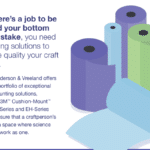New Tech for Pre-press, Press Room and Platemaking
An overview on how technology has changed the 3 Ps (Pre-Press, Press Room and Platemaking.
Is it time to update your equipment? The flexo industry has experienced a recent profusion of technological innovation, affecting every step of the flexographic printing process. Flexo Daily takes a look at how three key printing elements, pre-press, press room, and plate making, have been revolutionized by new technologies in the past few years. We spoke with Jessica Harkins, Technologies Manager at Anderson & Vreeland, about what’s new.
Pre-press
Then: Analog was king, and proofs were made using products like Kodak Approval and Dupont’s Digital Chromaline. Inkjet had yet to come into play across the board, being used mostly for just content proofing.
Now: We have seen the future and it is inkjet. With developments in inkjet technology, coupled with measuring instruments, consistent and exact color predictions are easier than ever. “Proofing types have changed in equipment, in quality, and in ability to match color,” says Harkins.
Ditch the FPO servers—computer hardware and software has developed in leaps and bounds. Systems now have the ability to handle full design files, and new software has simplified complex projects and helped increase automation and speed. Of course, designs have become more complex, thereby increasing file size.
Press Room
Then: Densitometers were around but not yet ubiquitous in the press room. J.I.T. was new but not yet common, and there were fewer CPCs and fewer methods of waste measuring.
Now: Tracking, minimizing waste and maximizing environmental accountability—the press room has changed to accommodate cost controls and environmental sustainability. The new eco-awareness has been driven, in part, by consumer product companies expecting accountability from flexo suppliers, and are measuring cost, performance, and eco-awareness.
Quality control devices are better than ever, and press room operators can now track pretty much everything, although there’s definitely been a learning curve, says Harkins. “Not everyone has jumped on board, but once educated, most see the value in taking the time to measure, track and analyze.”
Platemaking
Then: Digital plate making was new technology and expensive, pretty much reserved for larger outfits that could afford the outlay.
Now: Digital is now the norm, and means the capacity to print a larger tonal range. A new option that’s just made it to North America, says Harkins, is ink jetting specialty inks directly straight onto plate materials laminated with a primer sheet—the ink solidifies and creates a negative.
Enviro-sensitivity has made it to placemaking as well, with eco-friendly solvents and photopolymers that are water washable and low odor instead of the old-school harsh and environmentally damaging chemical solvents.
As package designs and substrates become more complex, and brand owners demand originality to distinguish and protect their products, look for even more technological innovations that will take flexo printing further into the digital age.
[box]Be sure to read Jessica’s 2013 State of the Industry piece, which talks about developments in inkjet, plus direct UV lasers, prototyping, and press room tools. We’ll be getting into more detail about technology and prepress, press room, and plate making in future Flexo Daily posts.[/box]
Contact us now to learn more about the latest products we offer.
[contact_form email=”rjerris@andvre.com” subject=”New Technology for Pre-Press, Press Room and Platemaking”]
[related_posts limit=”5″]
Related Read: Let the Magic Happen with Photopolymer Plates




